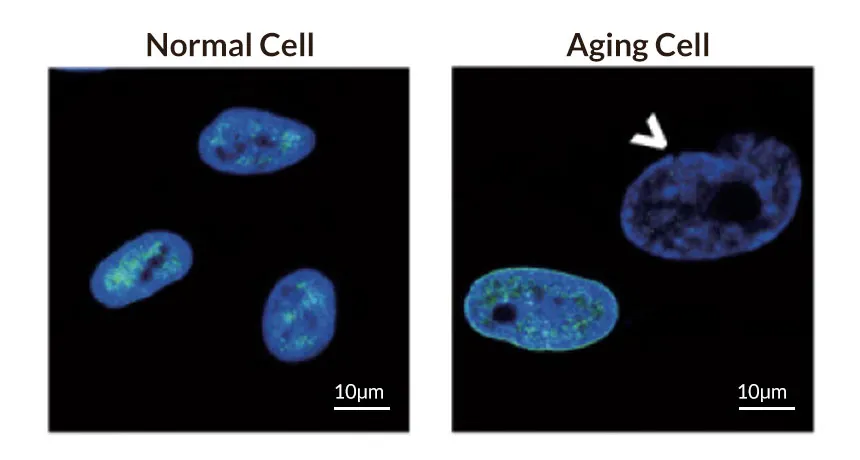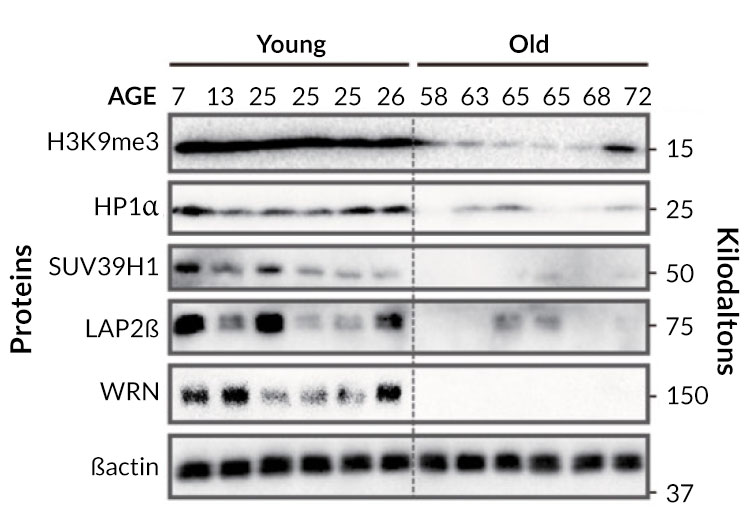DNA disorganization linked to aging
Study of adult progeria gene shows that resulting cell chaos leads to graying hair, brittle bones

NUCLEAR DISARRAY Normally tightly packed bundles of DNA (as in the normal stem cells, left) come undone in cells that age prematurely (right), enlarging their nuclei and promoting aging.
Zhang et al/Science 2015; Reprinted with permission from AAAS
- More than 2 years ago
Old cells do not go gently into that good night. In people who age prematurely, changes in the way that DNA is tightly packed in cells leads to mayhem that promotes the aging process, researchers have discovered.
Werner syndrome, a genetic disorder also known as adult progeria, leads to graying hair, cataracts, osteoporosis and other signs of aging in people in their 20s. Researchers investigating the syndrome found that mutations associated with the disorder disrupt DNA packaging. These packaging changes unleash genes that shouldn’t be turned on, promoting premature aging, an international team of scientists report online April 30 in Science.
The scientists also observed some of the same packaging changes in cells of otherwise healthy old people, suggesting that the alterations also drive ordinary aging. Future research into the process could lead to ways to treat age-related diseases and perhaps even to slow the advance of old age itself.
Aging is generally thought to result as cells lose the ability to repair and care for their DNA. Two main processes drive this breakdown: Damage to caretaker genes and the shortening of telomeres, the caps on chromosomes’ ends that maintain chromosome health and ensure smooth cell divisions. Both processes have been implicated in Werner syndrome. But the new research points to a third and overlooked mechanism: the disruption of tightly packed bundles of DNA called heterochromatin. When these bundled sections of the genome become disorganized, random stretches of DNA that are supposed to be inaccessible become exposed, resulting in cellular machinery gone wild.

“Aging has been very difficult to understand, and it may be that it happens differently in every person, although we all end up at the same place,” says Justine Miller, an expert in age-related diseases at the Neural Stem Cell Institute in Rensselaer, N.Y. While other drivers of aging can also lead to random genes being turned on, those effects pale in comparison with having whole stretches of DNA suddenly accessible and acted on by the cell when heterochromatin becomes disorganized, says Miller.
In the new work, a team led by scientists from the Salk Institute in La Jolla, Calif., and the Chinese Academy of Sciences created a stem cell line with a faulty Werner gene (WRN). The cells began to age more quickly than normal cells, and their nuclei, which house the DNA, were unnaturally enlarged. Compared with normal cells, the elderly cells also had far fewer of the chemical signposts that sit on heterochromatin and ensure that the DNA isn’t accessible. The loss leads to a cascade of events that disrupts the heterochromatin’s ability to stay organized in tidy bundles. This disruption can bring on features of old age: When the researchers stuck the abnormal cells into the muscles of mice, the muscles atrophied more quickly than those of normal mice.
The disruption of heterochromatin’s structure was surprising, says study coauthor Juan Carlos Izpisua Belmonte of the Salk Institute. That finding caused the team to wonder if disorganized heterochromatin could drive aging in healthy people. So the researchers looked for signs in stem cells taken from the dental pulp of six young people (ages 7 to 26) and six older people (ages 58 to 72). Sure enough, there were also fewer chemical signposts on the heterochromatin of the older people, suggesting that disorganized heterochromatin may be an important driver of aging in everyone.






